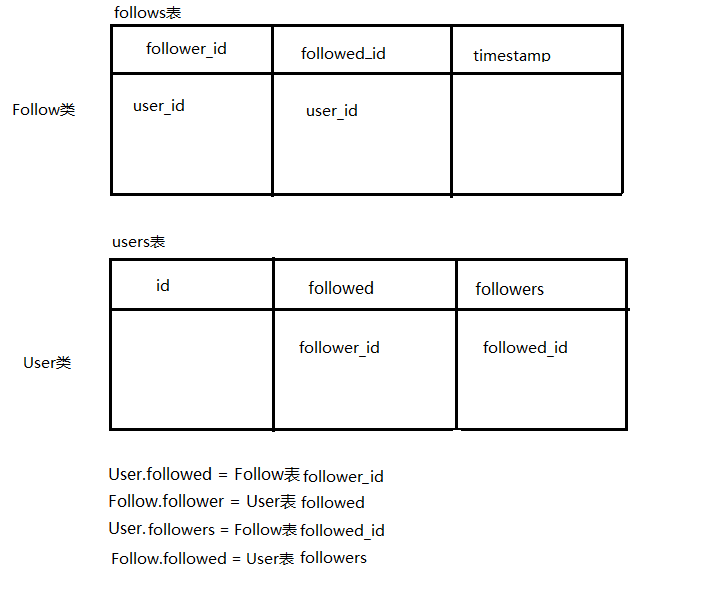flask_关注者
表的模型实现
class Follow(db.Model):
__tablename__ = 'follows'
follower_id = db.Column(db.Integer,db.ForeignKey('users.id'),
primary_key=True)
followed_id= db.Column(db.Integer,db.ForeignKey('users.id'),
primary_key=True)
timestamp = db.Column(db.DateTime,default=datetime.utcnow)
class User(UserMixin,db.Model):
#...
followed = db.relationship('Follow',
foreign_keys=[Follow.follower_id],
backref=db.backref('follower', lazy='joined'),
lazy='dynamic',
cascade='all, delete-orphan')
followers = db.relationship('Follow',
foreign_keys=[Follow.followed_id],
backref=db.backref('followed', lazy='joined'),
lazy='dynamic',
cascade='all, delete-orphan')

关注关系的辅助方法
class User(UserMixin,db.Model):
#...
#关注
def follow(self,user):
if not self.is_following(user):
f = Follow(follower=self,followed=user)
db.session.add(f)
#取关
def unfollow(self,user):
f = self.followed.filter_by(followed_id=user.id).first()
if f:
db.session.delete(f)
#正在关注
def is_following(self,user):
return self.followed.filter_by(
followed_id=user.id).first() is not None
def is_followed_by(self,user):
return self.followers.filter_by(
follower_id=user.id).first() is not None
在资料页中显示关注者
app/templates/user.html

{% if current_user.can(Permission.FOLLOW) and user != current_user %} {% if not current_user.is_following(user) %} <a href="{{ url_for('.follow',username=user.username) }}" class="btn btn-default">关注</a> {% else %} <a href="{{ url_for('.unfollow',username=user.username) }}" class="btn btn-default">取消关注</a> {% endif %} {% endif %} <a href="{{ url_for('.followers',username=user.username)}}"> Followers:<span class="badge">{{ user.followers.count() }}</span> </a> <a href="{{ url_for('.followed_by',username=user.username) }}"> Following:<span class="badge">{{ user.followed.count() }}</span> </a> {% if current_user.is_authenticated and user != current_user and user.is_following(current_user)%} |<span class="label label-default">Follows you</span> {% endif %}
app/main/views.py: ‘关注’路由和视图函数
@main.route('/follow/<username>')
@login_required
@permission_required(Permission.FOLLOW)
def follow(username):
user = User.query.filter_by(username=username).first()
if user is None:
flash(u'用户不存在')
return redirect(url_for('.index'))
if current_user.is_following(user):
flash(u'已关注')
return redirect(url_for('.user',username=username))
current_user.follow(user)
flash('You are now following %s.'%username)
return redirect(url_for('.user',username=username))
@main.route('/unfollow/<username>')
@login_required
@permission_required(Permission.FOLLOW)
def unfollow(username):
user = User.query.filter_by(username=username).first()
if user is None:
flash('Invalid user.')
return redirect(url_for('.index'))
if not current_user.is_following(user):
flash('You are not following this user.')
return redirect(url_for('.user', username=username))
current_user.unfollow(user)
flash('You are not following %s anymore.' % username)
return redirect(url_for('.user', username=username))
@main.route('/followers/<username>')
def followers(username):
user = User.query.filter_by(username=username).first()
if user is None:
flash('Invalid user.')
return redirect(url_for('.index'))
page = request.args.get('page', 1, type=int)
pagination = user.followers.paginate(
page, per_page=current_app.config['FLASKY_FOLLOWERS_PER_PAGE'],
error_out=False)
follows = [{'user': item.follower, 'timestamp': item.timestamp}
for item in pagination.items]
return render_template('followers.html', user=user, title="Followers of",
endpoint='.followers', pagination=pagination,
follows=follows)
@main.route('/followers/<username>')
def followers(username):
user = User.query.filter_by(username=username).first()
if user is None:
flash('Invalid user.')
return redirect(url_for('.index'))
page = request.args.get('page', 1, type=int)
pagination = user.followers.paginate(
page, per_page=current_app.config['FLASKY_FOLLOWERS_PER_PAGE'],
error_out=False)
follows = [{'user': item.follower, 'timestamp': item.timestamp}
for item in pagination.items]
return render_template('followers.html', user=user, title="Followers of",
endpoint='.followers', pagination=pagination,
follows=follows)
使用数据库联结查询所关注用户的文章
要想只查看关注用户的文章需要把posts表和follows表联结起来查询
class User(UserMixin,db.Model):
#..
@property
def followed_posts(self):
return Post.query.join(Follow,Follow.followed_id == Post.author_id)\
.filter(Follow.follower_id == self.id)
Post表联结Follow表 Follow表被关注 = 文章作者的id 查找 Follow表中关注者的id
在首页显示所关注用户的文章
app/main/views.py:显示所有博客文章或只显示所关注用户的文章
@main.route('/', methods=['GET', 'POST'])
def index():
#...
show_followed=False
if current_user.is_authenticated:
show_followed = bool(request.cookies.get('show_followed',''))
if show_followed:
query = current_user.followed_posts
else:
query = Post.query
pagination = query.order_by(Post.timestamp.desc()).paginate(
page, per_page=current_app.config['FLASKY_POSTS_PER_PAGE'],
error_out=False)
posts = pagination.items
return render_template('index.html', form=form, posts=posts,show_followed=show_followed,
pagination=pagination)
决定显示所有文章还是只显示所关注用户文章的选项存储在cookie的show_followed字段中,如果其值为非空字符串,则表示只显示所关注用户的文章。
query的值决定最终获取所有博客的查询,或是获取过滤后的博客文章查询
app/main/views.py:查询所有文章还是所关注用户的文章
@main.route('/all')
@login_required
def show_all():
resp = make_response(redirect(url_for('.index')))
resp.set_cookie('show_followed','',max_age=30*24*60*60)
return resp
resp返回一个响应,然后为它的cookie设置为 show_followed为空,过期时间为一个月
@main.route('/followed')
@login_required
def show_followed():
resp = make_response(redirect(url_for('.index')))
resp.set_cookie('show_followed','1',max_age=30*24*60*60)
return resp
resp返回一个响应,然后为它的cookie设置为 show_followed不为空,过期时间为一个月,表示只显示只看所关注用户的文章
接下来改动模板
<div class="post-tabs">
<ul class="nav nav-tabs">
<li {% if not show_followed %}class="active"{% endif %} ><a href="{{ url_for('.show_all') }}" >全部</a></li>
{% if current_user.is_authenticated %}
<li {% if show_followed %}class="active"{% endif %}><a href="{{ url_for('.show_followed') }}">关注</a> </li>
{% endif %}
</ul>
app/model.py:构建用户时把用户设为自己的关注者
def __init__(self,**kwargs):
self.follow(self)
app/models.py:把用户设为自己的关注者
@staticmethod
def add_self_follows():
for user in User.query.all():
if not user.is_following(user):
user.follow(user)
db.session.add(user)
db.session.commit()
(venv) >python manage.py shell >>> User.add_self_follows()
把关注者数量减一
<a href="{{ url_for('.followers',username=user.username)}}">j
Followers:<span class="badge">{{ user.followers.count() - 1 }}</span>
·




